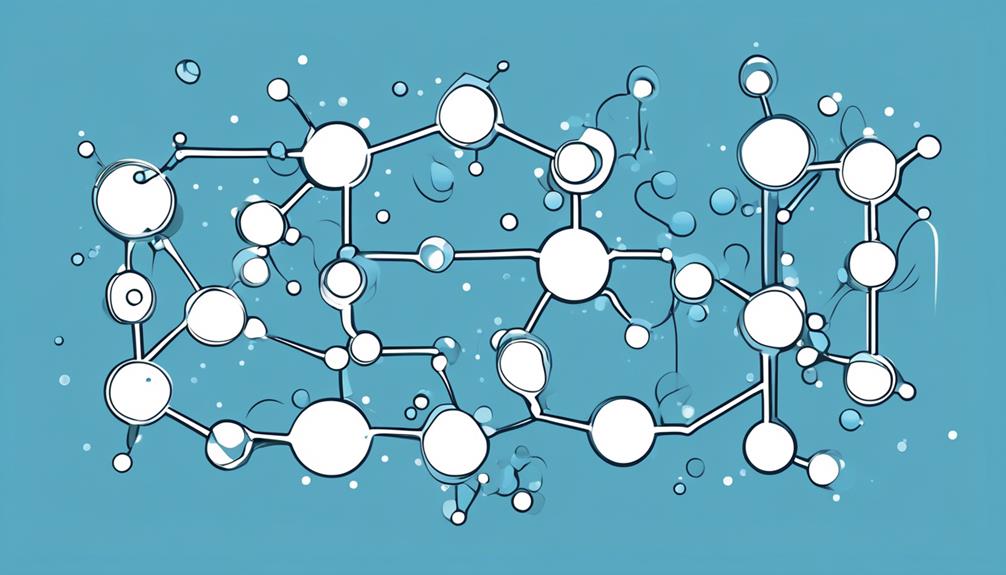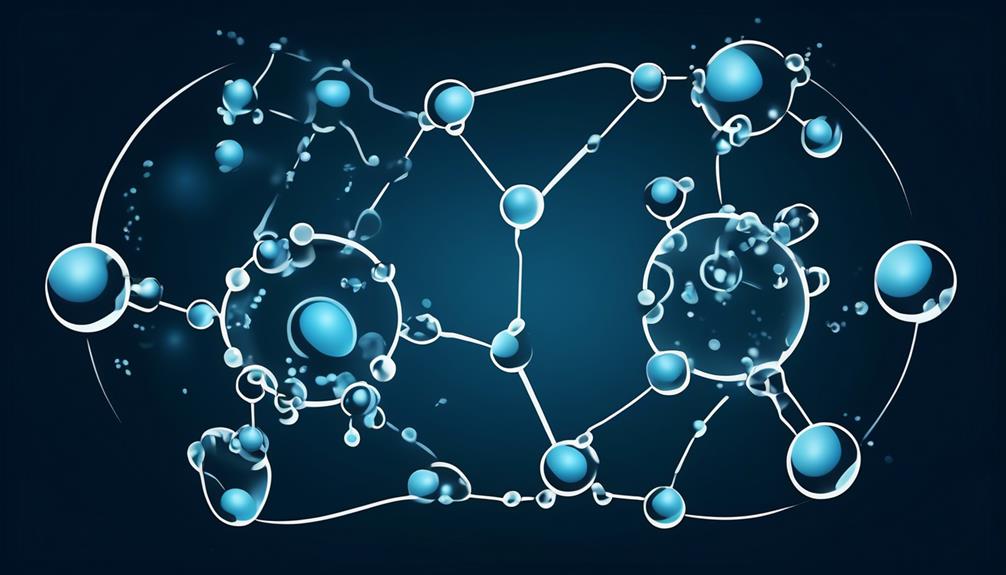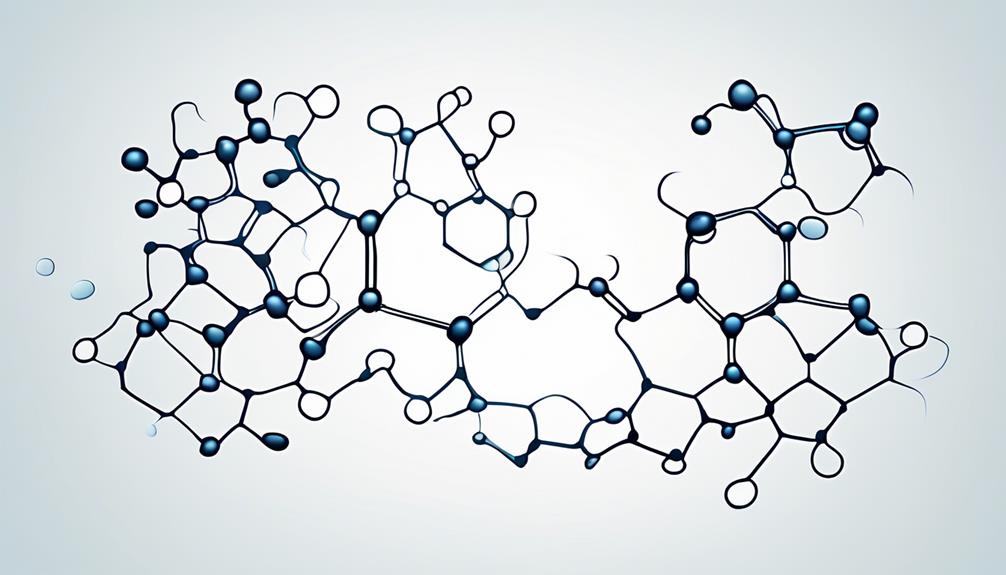You might ponder why water molecules stand out among the crowd, and the answer lies in their exceptional behavior. Picture this: water's unique molecular structure, with oxygen and hydrogen atoms dancing in an asymmetrical tango, creates a magnetic pull between them. This magnetic attraction forms polar covalent bonds, giving water its dipole nature.
But what does this mean for you? Well, it's this very characteristic that makes water a superstar in the world of chemistry, with its ability to defy norms and influence everything from climate patterns to the very essence of life itself.
There's more to this watery tale, so stick around to uncover the mysteries behind water's intriguing quirks.
Key Takeaways
- Polar covalent bonds create partial charges due to oxygen's higher electron attraction, leading to crucial hydrogen bond formation.
- Hydrogen bonds in water molecules exhibit strong intermolecular attractions, influencing water's unique properties like high surface tension and heat capacity.
- High surface tension, a result of hydrogen bonding, plays a vital role in life support, rain formation, and nutrient transportation.
- Water's solvation ability allows for the dissolution of a wide array of substances, essential for biological functions, nutrient transportation, and understanding natural processes.
Water's Polarity and Its Significance
Water's polarity, characterized by its uneven distribution of charge, is a fundamental property that influences its behavior and significance in natural processes. This polarity arises from the arrangement of oxygen and hydrogen atoms in a water molecule, creating a positive and a negative end.
This unique feature allows water to form hydrogen bonds, which are crucial for various functions. Hydrogen bonding gives water its high surface tension, allowing small insects to walk on water, and its high heat capacity, regulating temperature changes in oceans and bodies of water.
Moreover, this property of water contributes to its ability to dissolve substances, making it a universal solvent in nature. The polarity of water also plays a vital role in the Earth's climate system by affecting heat distribution and driving the water cycle.
Understanding the polarity and hydrogen bonding of water helps explain its anomalous behavior and why it's essential for supporting life on Earth.
Hydrogen Bonds in Water Molecules
When water molecules come together, they form strong intermolecular attractions known as hydrogen bonds. These bonds are what give water its unique molecular structure and contribute to properties like high surface tension.
Picture water molecules holding hands tightly through these hydrogen bonds, showcasing their strong affinity for one another.
Strong Intermolecular Attractions
Frequently, hydrogen bonds within water molecules create unique properties essential for supporting life and shaping the planet's geology. When considering the strong intermolecular attractions in water:
- High Heat Capacity: Hydrogen bonds allow water to absorb a lot of heat before temperature changes, making it vital for regulating Earth's climate.
- Surface Tension: The cohesion from hydrogen bonding gives water molecules the ability to stick together, forming droplets and supporting life on a macroscopic scale.
- Interactions with Other Molecules: Hydrogen bonds enable water to interact with other polar molecules and ions, making it a universal solvent and facilitating biochemical reactions.
These interactions showcase how hydrogen bonds in water molecules influence its behavior and are crucial for various aspects of life and the environment.
Unique Molecular Structure
Exploring the unique molecular structure of water molecules, particularly the hydrogen bonds they form, reveals a fundamental aspect of their behavior that influences various natural phenomena. Water's unique properties stem from its polar covalent bonds, where oxygen attracts electrons more strongly than hydrogen, creating a partial negative charge near oxygen and partial positive charges near hydrogen. These polar molecules can form hydrogen bonds due to the attraction between the positive hydrogen atoms and negative oxygen atoms of neighboring molecules. This molecular arrangement gives water its high heat capacity, allowing it to absorb and release large amounts of heat without significant temperature change. The interplay of these hydrogen bonds contributes to the extraordinary properties of water that support life on Earth.
| Unique Properties | High Heat Capacity | Polar Covalent |
|---|---|---|
| Water exhibits unique behavior due to its properties. | Water has a high heat capacity, crucial for temperature regulation. | Water's polar covalent bonds create partial charges. |
High Surface Tension
Water's high surface tension, a result of hydrogen bonding, is a remarkable characteristic that influences numerous natural phenomena. When you think about high surface tension in water molecules, consider the following:
- Droplet Formation: The high surface tension of water allows it to form droplets, crucial for rain formation and water movement in plants.
- Life Support: This unique property enables water to support life processes, from nutrient transportation in cells to the buoyancy of aquatic organisms.
- Environmental Impact: The high surface tension of water plays a role in Earth's climate regulation by affecting weather patterns and ocean currents.
These aspects showcase how hydrogen bonds in water contribute to its distinctive behavior and significance in nature.
The Intriguing Solvation Ability of Water
With its remarkable ability to dissolve a wide array of substances, water showcases a captivating solvation prowess that underpins various essential processes in nature and living organisms.
The water molecule's unique structure, with oxygen attracting electrons more strongly than hydrogen, forms hydrogen bonds. These bonds give water its high boiling point and remarkable solvent properties.
When substances dissolve in water, the water molecules surround and separate the solute particles, forming a hydration shell. This process is vital for biological functions, like transporting nutrients in plants and animals.
Water's solvation ability is also crucial in forming solutions like the bloodstream in humans. The hydrogen bonds in water make it an excellent solvent for polar and ionic compounds, playing a significant role in various chemical reactions.
Understanding water's solvation prowess is key to comprehending the mechanisms behind many natural processes and life itself.
Unpacking Water's Density Quirks

Alright, let's talk about water's density quirks.
When it comes to density and temperature, water behaves in a unique way that impacts its properties.
The effects of hydrogen bonding play a key role in understanding why water acts the way it does, leading to anomalous expansion behavior that sets it apart from other substances.
Density and Temperature
At 4 degrees Celsius, water achieves its highest density, a crucial characteristic that impacts various natural phenomena. This unique trait of water can be fascinating to explore. Let's dive into why water's density and temperature relationship matter:
- Density Sweet Spot: Water is heaviest at 4 degrees Celsius, making it vital for aquatic ecosystems.
- Lake Depths: Freshwater lakes often have a temperature of 4 degrees at their deepest points, showcasing this density peculiarity.
- Ice Formation: Ice, being less dense, floats on water, insulating the liquid below and supporting marine life.
Understanding how water's density changes with temperature provides insights into its role in the environment.
Hydrogen Bonding Effects
Water's density at 4 degrees Celsius not only impacts aquatic ecosystems but also plays a crucial role in unraveling the hydrogen bonding effects that give rise to its intriguing density quirks. When water molecules form hydrogen bonds, they exhibit unique behaviors like high surface tension, capillary action, and thermal regulation. These effects are a result of the asymmetrical arrangement of oxygen and hydrogen atoms within the molecule. The hydrogen bonds between water molecules create a network that influences the substance's density, heat capacity, and ability to dissolve various solutes. Understanding these hydrogen bonding effects is key to comprehending why water behaves differently from other liquids, making it essential for life and shaping Earth's landscapes.
| Hydrogen Bonding Effects | Water Molecules | Unique Behaviors |
|---|---|---|
| High Surface Tension | Asymmetrical | Capillary Action |
| Thermal Regulation | Hydrogen Bonds | Dissolving Ability |
Anomalous Expansion Behavior
In exploring the anomalous expansion behavior of water, one discovers a fascinating interplay of factors that contribute to its unique density quirks. When it comes to water's density, here's what you need to know:
- Liquid Density Dance: At 4 degrees Celsius, water is at its densest, unlike most substances. As the temperature drops below or rises above this point, the density of water changes unexpectedly.
- Ice Ice Baby: Ice is less dense than liquid water, which is why it floats. This unique property has significant implications for aquatic life and Earth's climate.
- Temperature Tricks: Water's density anomalies are closely linked to temperature shifts, impacting ocean currents and weather patterns. Understanding these quirks is crucial for various environmental processes.
High Heat of Vaporization Mystery

Mystifying researchers worldwide, the unusually high heat required to turn water into vapor continues to puzzle scientists. This high heat of vaporization mystery is a crucial aspect of why water molecules behave uniquely compared to other substances. Imagine this: when you heat water, it doesn't just evaporate instantly like rubbing alcohol on your skin. Instead, it takes a significant amount of heat to break the hydrogen bonds holding water molecules together, allowing them to escape into the air as vapor.
This high heat capacity of water plays a vital role in our environment. For instance, it helps moderate Earth's climate by absorbing heat from the sun during the day and releasing it slowly at night. This phenomenon also influences weather patterns, ocean currents, and even the stability of ecosystems.
In essence, the mystery behind water's high heat of vaporization isn't just a scientific curiosity but a fundamental piece of what makes our world function as it does.
Deciphering Water's Unique Properties
Discover the extraordinary characteristics of water molecules through unraveling their unique properties.
- Liquid Density Anomaly:
- Water reaches its highest density at 4 degrees Celsius, unlike most other substances that are densest in their solid state.
- Ice floats on water due to its lower density, a rare phenomenon crucial for aquatic life.
- Freshwater lakes maintain a temperature of 4 degrees at their deepest points, supporting various ecosystems.
- Hydrogen Bonding:
- Water's asymmetrical arrangement of oxygen and hydrogen atoms results in a dipole nature with positively and negatively charged ends.
- Hydrogen bonds between water molecules contribute to its high heat capacity, second only to ammonia.
- Water can absorb significant heat before boiling, making it essential for moderating temperatures on Earth.
- High Heat of Vaporization:
- Water's ability to absorb large amounts of heat before transitioning to vapor is critical for regulating global climate patterns.
- The efficient absorption of infrared radiation by water vapor amplifies the greenhouse effect, influencing Earth's heat budget.
- Water's distinct properties in its liquid, solid, and vapor states play a vital role in sustaining life on our planet.
Exploring Water's Chemistry Depths

Delve into the depths of water's chemistry to uncover its intricate molecular interactions and captivating properties. When exploring the chemistry of water molecules, it's fascinating to understand how its structure influences its behavior. The water molecule consists of two hydrogen atoms and one oxygen atom, creating a unique asymmetrical arrangement. This structure leads to the formation of hydrogen bonds, which are crucial for many of water's properties.
| Water Molecule Consists | Hydrogen Bonds | Properties |
|---|---|---|
| Two hydrogen atoms | Form between | High heat capacity |
| One oxygen atom | Hydrogen and | Absorbs large amounts |
| oxygen atoms | of heat |
These hydrogen bonds contribute to water's high heat capacity, allowing it to absorb significant heat energy before boiling. Furthermore, these interactions are responsible for water's cohesive and adhesive properties, its ability to moderate temperature changes, and its importance in various biological processes. Understanding the chemistry of water at the molecular level unveils the secrets behind its unique behavior and essential role in our world.
Frequently Asked Questions
What Makes a Water Molecule so Unique?
Water molecules are exceptional because of their structure. The oxygen atom's strong pull on electrons creates a bent shape with hydrogen atoms. This causes polarity, making water stick together and interact uniquely with other substances.
Why Does Water Behave Differently?
Water behaves differently due to its molecular structure, forming hydrogen bonds. These bonds create surface tension, capillary action, and high specific heat. Understanding these unique properties helps explain why water is vital for life and various phenomena.
What Is the Reason That Water Has the Unique Properties That It Does?
Water's extraordinary properties, like density and boiling point, stem from its asymmetric oxygen-hydrogen arrangement. Its bent structure and hydrogen bonds underlie characteristics such as high heat capacity and solvent ability, making water truly exceptional.
What Makes Water so Peculiar?
Water's peculiarity lies in its molecular structure. Hydrogen bonds between water molecules create cohesion, adhesion, surface tension, and high specific heat. These unique properties make water essential for life and give it the ability to dissolve many substances.
Conclusion
So, when you look at water, think of it like a magical dancer twirling gracefully on stage. Its polarity and hydrogen bonds give it the ability to attract and interact with other molecules, just like how the dancer captivates the audience.
The quirks in water's density and high heat of vaporization are its unique moves that make it stand out in the chemistry world. Water truly is a special performer on the stage of life.
